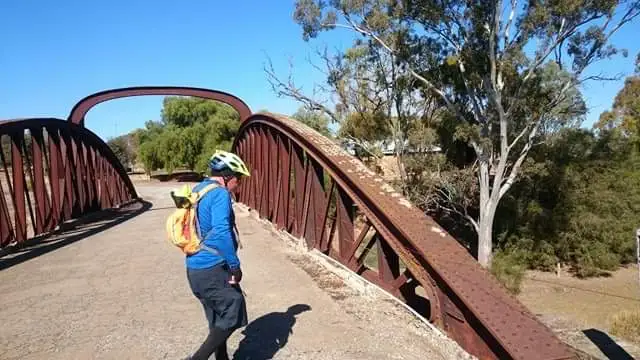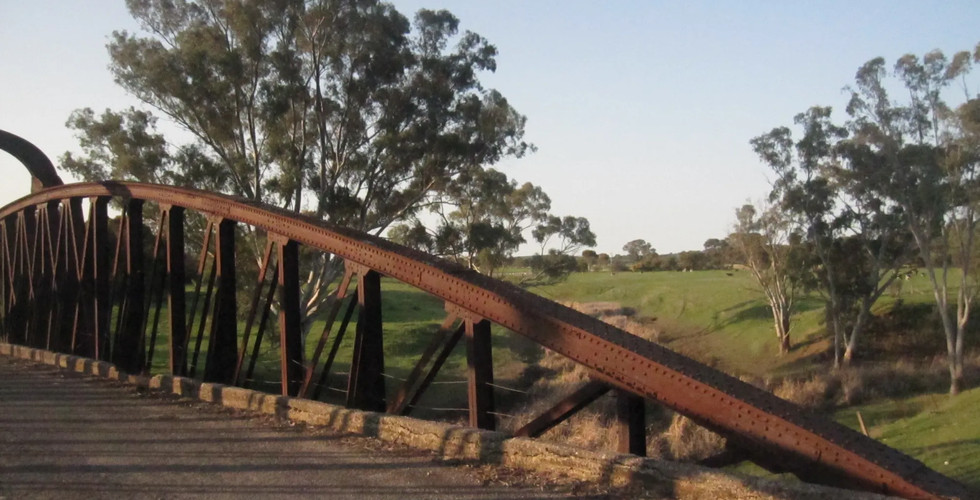Old Undalya on the Wakefield
- Jon Ruwolt
- Sep 21, 2024
- 6 min read
Updated: Oct 1, 2024
Undalya is a small settlement in the Clare Valley. Its name, meaning water holes, is taken from the local Ngadjuri people who occupied the area at the time of European colonisation.

Undalya is located on the Horrocks Highway approximately halfway between the towns of Auburn and Rhynie, at the junction of the River Wakefield and Pine Creek. To the east lies the town of Saddleworth and to the south-west lies the town of Balaklava.
The surrounding district was known as Kercoonda meaning "camp near water". In the early years of the village, Aborigines were in great numbers in the district.

Being an early thriving township, Undalya consisted of the usual business houses and hotels, with the first local post office opening in 1848.
Before the two churches were built or the one at Penwortham, a local property occupier, a JP, conducted a wedding in the property Head Station front room.

The nearest places are Auburn, 4 miles N., and Rhynie, 5 miles S., there being communication by mail car daily. With Adelaide, 75 miles South;
The communication in 1866 was by mail coach to Kapunda, and thence by rail. Undalya had 1 hotel ---the Undalya--- a post office, and a fine church.

There is a bridge over the river Wakefield at the township, by which the main North road crosses. The surrounding country is elevated and somewhat hilly at a little distance from the river. The population numbers about 80 persons.

The Undalya area was at its busiest in the 1850s and 1860s with steady traffic between the Burra copper mines and Port Wakefield and later the migration of miners from Burra to the new copper mines at Moonta.
Local property owners and those transversing on the Great Northern Road opening up the country to the north, needed to take produce to market and get supplies.
The need for a bridge across the sometimes heavily swollen Wakefield River was apparent from the earliest days of the mining boom. The first bridge of 1855 was built by Auburn stonemasons, Meller and Scott.
One of the most impressive bridges in the State followed, this current bridge, affectionately known as “the basket bridge”, built in 1879.
Undalya’s amazing single span iron bridge across the Wakefield River in the Clare Valley is 140 years old. This masterful piece of Victorian era engineering is in need of care and conservation to ensure it remains intact and useable in the future.
In later years, Undalya was the site of a large-scale wool scouring operation begun by George Henry Michell in 1870, an emigrant from Cornwall.
The enterprise established by G.H. Michell, now working on an international scale, is still successfully operated by the Michell family out of Adelaide.
Today, Undalya is a sleepy shadow of its former industrious past. The bridge is a local icon, but one in need of care and conservation.
An exhibition by artists Suzanne Laslett and James Parker highlighted the unique character and fond associations of the bridge for many people.
UNDALYA


The boys of the local school had a pleasant surprise last week, when a visit was paid to the school by Mr. J. Michell, an old scholar of nearly 50 years ago.
He was a member of the old wool-broking firm, whose wool-scouring activities were carried on at that place in earlier days.
Mr. Michell chatted to the children, and then made them a present of a cricket set as a reminder of his schooldays.
The family and friends of John Michell gathered in Adelaide last week to farewell one of the key figures of the wool industry. The 80-year-old died after a short battle with cancer.
For more than 60 years, he worked for his family's wool carbonising and scouring company Michell, including three decades as Managing Director.
Grazier and former Federal Liberal MP Ian McLachlan described Mr Michell as "very forthright, had his own views but always a great representative of the wool industry and the wool processing industry in particular."
John Michell came from a family tradition of entrepreneurs. His great-grandfather was a shoe maker who migrated to South Australia from Cornwall and set up a business in the Clare Valley.

He expanded his business to washing wool in the Wakefield River before he and his sons bought a tannery at Hindmarsh, where they began wool washing in the River Torrens and later added knitting and spinning operations.
John Michell was in charge of the company when it shifted from Hindmarsh to Salisbury where it became the largest wool carbonising plant in the country.
Now the firm has grown into the largest of its type in the world, processing an estimated 20 per cent of the global wool clip but not before almost shutting its doors a decade ago.

Sons David and his brother Peter Michell followed in their father's footsteps by taking over the running of the company and showed the family tradition for taking risks by buying out their 38 cousins.
They then set about saving the company by radically re-inventing its processes for greater efficiency and quality.
"We took a plant that did 600 kilograms an hour to one that now does 1250 kilograms with the same amount of water so it reduced our energy consumption across the board by half," says Peter Michell.
The brothers then took an enormous risk by taking the Chinese on in their own backyard. They bought land in Suzhou, China and built a carbonising factory capable of processing wool from Europe, South Africa, South America and Australia.
The Land Army at Undalya
Flax was found to have many applications in the manufacture of WW2 war equipment and many Australian farmers grew it for that purpose.
This RHS photograph shows flax fibre being inspected under a microscope. (Donor Department of Information)




Mr. T. Howard's home is notable for having served as the Land Army Hostel, and a Michell building is now Howard's shearing shed.

Bitumen Road to Clare
The Royal Automobile Association reported last week that, with the exception of a stretch of two or three miles between Undalya and Auburn, a good bitumen surface extended from Adelaide to Clare, 82 miles.
The Highways Department is engaged in completing the short stretch between Undalya and Auburn, which is closed from 7 a.m. to 5.30 n.m. (week days and holidays excepted). Local deviations are provided, and it as expected that operations will be completed in two to three weeks (actually in 1939).
Re-Building the Undalya Bridge
South Australian Advertiser (Adelaide, SA), Saturday 19 April 1879, page 14
THE UNDALYA BRIDGE.

The Undalya Bridge, which has recently been completed by the Midland District Road Board, was (says the Kapunda Herald) formally opened on Thursday, March
13, 1879.
The old bridge, which was erected twenty-four years since, had four openings. Of late it had been a constant source of bother and expense to the Board in shoring it up and making it capable of bearing the traffic ; so that at the last appropriation for construction purposes it was decided to erect a bridge of a thoroughly permanent character—the result being the construction of the present handsome structure.
Corrugated boiler plates are employed for the bridge flooring; the plates are 6 feet long and 14 inches thick, riveted at ends to the cross girders, lapped and riveted at the longitudinal joint.
It is then covered with asphalt and a layer of Portland cement concrete, on which the usual road metal is placed. The main girders are each about 23 tons, and total weight of the bridge about 61 tons. It was found necessary to pull down a large portion of the abutments of the old bridge, the old masonry not being wide enough or of sufficient strength to carry the new work.
This portion of the work, together with the approaches, has been carried out in a very satisfactory manner by the contractor, Mr. C. S. Baillie. The contractor for the ironwork throughout, and also for erecting the bridge, was Mr. J. Hooker, of Hindley-street, who has also done his work very satisfactorily.
The bridge was designed by Mr. J. Morris, C.E., the Superintending-Surveyor for the Board, and carried out under his supervision.
The Chairman having amidst loud cheering formally declared the bridge open to tbe public, a brief adjournment to the hotel was made, where in a few happy sentences the Chairman alluded to the bridge they had that day opened, which he hoped and believed would be as good and useful in generations to come as it was now.



In 1950 the entire supporting structure was replaced:



Read more:
References:
































Love all this information...... particularly, due to all the bad news in the Advertiser each day ! Can't wait, to move to the beautiful Clare Valley and love life again !!!! I, often wonder, how Hamish Gosse is travelling..... Kadlunga Gentry man, someone whom deserves respect.
Bill Bagley.... Legend in Woolclassing History
I still, have no idea, where the Michell's family actually lived.... I can see a handfull of houses from the Horrocks h/way, but I wonder still, as to which house they may have lived in !!! I have bought a block... in Sevenhill.... and if I live long enough, may build a cottage for Jeffrey and Kellie to live out their lives in God's country......
Undalya has always been a mystical place to me..... small cottages clean air, marino sheep and friendly Aussie people. I am an old Woolclaser... have always wondered were the Michel family lived... Back in the day, I regularly visit on the way to my block at Sevenhill. There are only a handfull of houses visible from the Horrocks Highway..... I would love to know which house belonged to the Michel's. I remember, whilst at the wool school...at Marleston, a beautiful young lady whom taught us boys about Micron measurement.... I think her name was Cathy...a real Honey. She, was... I am told, Knocking around with one of the Michel boys.... 1973 I think !!!!